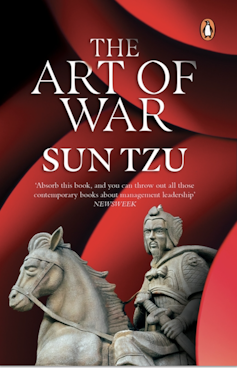Quoting The Art of War, an ancient Chinese war manual from the 5th century BCE, has become a cliché. Unfortunately, it is the trademark of teenage edgelords, management gurus and, as one of my students informed me, pseudo-intellectual friends.
For all these reasons, the book has become part of the endless irony that forms the foundation of internet culture. Various memes reference the book’s famous lines, such as “Know your enemy, know thyself” and “Don’t put too much pressure on a desperate enemy,” and poke fun at these excessive references.

penguin
But there is substance behind this cliché. The Art of War, supposedly written by the Chinese general and strategist Sun Tzu, is a work of astute and sometimes brutal realism. And no matter how much we wish for a gentler world, as long as people continue to seek power, often at the expense of good, realistic works will continue to interest us.
With its aphoristic style, The Art of War is also very easy to read (and quote). Although it was written 2,500 years ago, it feels familiar rather than foreign. The work has been translated into many languages and millions of copies have been sold.
The Art of War is short: 6,000 Chinese characters, or about 15,000 English words, depending on the translation. It consists of 13 chapters, each of which covers a different aspect of warfare, such as “Planning an Attack” or “Conformations of the Land.”
Some of the more ruthless advice includes:
Put your troops in situations where they have no way out, and they will face death and never back down.
Or:
If a case of espionage is discovered prematurely, not only the spy but also all the people he confided in must die.
However, there are also a number of drier military tactics, such as “Do not attack an enemy who is in a higher position” or “Do not follow an enemy who is feigning a retreat”.
The book draws on both philosophy and strategy, which has contributed significantly to its longevity. (Interestingly, in ancient Chinese literature, unlike ancient Western works, discussions of military affairs and philosophy are often combined, as Roger Ames, a translator of the book, notes.)
Because of its philosophical qualities, the art of war is relevant not only in war, but also in business, sports, and even courtship.
One of the most frequently quoted sayings is the infinitely versatile one:
Know the enemy, know yourself, and you will not be in danger in a hundred battles. If you do not know the enemy, but know yourself, you will win and lose by turns. If you do not know the enemy or yourself, you will surely lose every battle.
In a similar way:
Those who excel in battle can make themselves invincible, but they cannot always make their enemies vulnerable.
Authorship
The book is attributed to Sun Tzu, but its authorship is unclear. According to the Records of the Grand Historian of Sima Qian (91 BCE), the great military strategist Sun Wu, whom we know as Sun Tzu or Master Sun, served the state of Wu at the end of the Spring and Autumn period (around 500 BCE) and was in fact the author of The Art of War.

Wikimedia Commons
But these records are a mixture of fact and legend. The earliest written fragments of the Art of War date from around 200 BC – 300 years after Sun Wu’s lifetime. Therefore, it is difficult to verify Sima Qian’s claims.
Historian Michael Nylan, who did the translation I’m using for this article, says the scholarly consensus is that all early Chinese texts are “composite texts.” They were compiled over time—sometimes for centuries—before crystallizing into a final written version.
They are attributed to a single author; however, it is likely that that author never existed, or, as the joke goes, classic works such as The Art of War by Sun Tzu were written by someone else with the same name.
However, since I cannot think of a better option, I will attribute the book, like all the others, to Sun Tzu: Master Sun.
The context
The Spring and Autumn period (c. 771–476 BCE) of Chinese history was characterized by numerous small states, often engaged in ritual conflicts. These conflicts were fought by aristocrats, and there were few deaths.

vlasta2, bluefootedbooby on flickr.com, CC BY
During the Warring States Period (c. 475–221 BC), the states united into seven: Qi, Chu, Yan, Han, Zhao, Wei and Qin.
These states waged relentless wars. Back then, conflicts were real, not ritualized. Tens of thousands and sometimes hundreds of thousands of soldiers – ordinary people, not aristocrats – went into battle.
This change in warfare was accompanied by a change in strategies and tactics. The Art of War is a document of this change.
The King’s Concubines
A story is told in the Records of the Grand Historian about Sun Wu’s first meeting with King Helü of Wu. This story is worth mentioning, even though it may be apocryphal, as it further cements Master Sun’s reputation as a perceptive and ruthless individual.
The king wanted to test Sun Wu’s skills, so he summoned 180 of his concubines and asked him to conduct a military exercise with them. Sun Wu divided the concubines into two groups and placed each under the care of one of the king’s favorites. Sun Wu repeatedly explained how he wanted the concubines to exercise. However, when he was ordered, they giggled and disobeyed.
Sun Wu noted that it was the commander’s fault if instructions were not clear. He repeated what he wanted. Again he was disobeyed. Then he noted that it was the unit commander’s fault if instructions were clear but not followed. Therefore, he ordered the two leading concubines to be beheaded.
The king refused to do so. Sun Wu said that once an order was given, the king no longer had any power.
The two concubines were executed.
Two more leading concubines were appointed and the groups practiced perfectly. Sun Wu was appointed as the king’s military commander.
Parts of this story are reflected in “The Art of War”:
If the way he goes into battle guarantees victory, the commander must insist on fighting even if the ruler forbids confrontation. And if the way he goes into battle does not guarantee victory, he must refuse to fight even if the ruler insists.
realism
The Art of War is Machiavellian – in the best sense of the word. What do I mean by that? The battle between good and evil is a familiar theme. We could say that good is something like treating others as we would like to be treated, and evil is something like taking pleasure in cruelty. It’s easy to think that most of the time we have to choose between one or the other.

Wikimedia Commons
However, as we see in both Machiavelli’s writings and in The Art of War, there is a middle way that we can call “realism.” To paraphrase Machiavelli’s advice, a ruler does not deviate from the good when he or she can, but when necessity demands it.
As we have seen, Master Sun encourages reckless action in some cases. He also regularly encourages deception; for example, he advocates the use of “underhand” rather than “direct” tactics (although this is hardly notable in war).
But – and this is the crucial point – for Master Sun, war is not fun: it lacks the familiar glorification of heroism that we see in works such as Homer’s Iliad and many militaristic cultures. The most striking remarks in The Art of War are:
Winning a hundred victories in a hundred battles is not the best result. The best thing is to subdue the enemy’s troops without ever facing them on the battlefield.

Shutterstock
We also see Master Sun advising rulers not to mobilize their forces in anger. Wars, he writes, should not be fought over an insult. After all, “a kingdom once destroyed cannot be restored, nor can the dead be raised to life again.”
And yet, as international relations expert John Herz (who coined the term “security dilemma”) notes, “Realism may well, and often does, glorify ‘realist’ tendencies as the desirable ones.”
This critical objection suggests that some people who appear to be realists do not deviate from good out of unfortunate necessity, but rather hide their evil behavior behind the rhetoric of realism. Even a superficial examination of history shows that such behavior is all too common.




